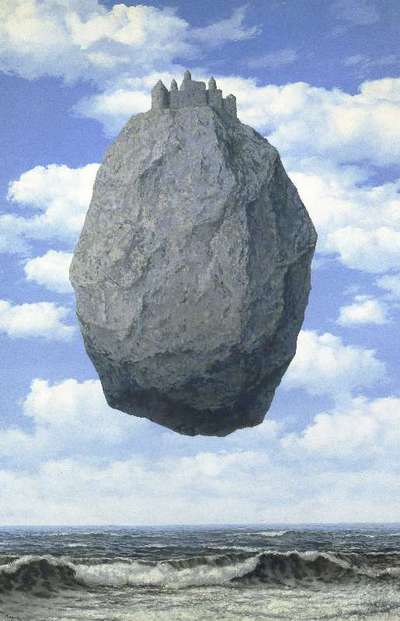Javascript must be enabled to continue!
The Castle of the Pyrenees
View through Europeana Collections
Belgian Surrealist René Magritte’s masterpiece The Castle of the Pyrenees was commissioned by the artist’s longtime friend, the international lawyer, poet, and author Harry Torczyner. The unfolding of the commission and evolution of the painting are documented in letters between the two men, which were published by the Israel Museum in 1991. Though Magritte had complete freedom, the correspondence reveals that his patron was encouraged to express his opinions on the choice of a subject. From a number of drawings proposed by Magritte, Torczyner selected one of a large rock surmounted by a castle. Intimately acquainted with the artist’s repertoire, Torczyner added the suggestion of a sky on a clear day and a rough darkish sea “because over the dark sea or ocean there rises the rock of hope, topped by a fortress, a castle.” As Magritte refined the painting, he decided to exclude other proposed additions so that it would retain the “vigor” and “harshness” he envisioned. The Castle of the Pyrenees has become one of Magritte’s best known and most-reproduced images. It embodies the artist’s typical disturbing juxtaposition of familiar objects, combined with captivating poetry and mystery.
Title: The Castle of the Pyrenees
Description:
Belgian Surrealist René Magritte’s masterpiece The Castle of the Pyrenees was commissioned by the artist’s longtime friend, the international lawyer, poet, and author Harry Torczyner.
The unfolding of the commission and evolution of the painting are documented in letters between the two men, which were published by the Israel Museum in 1991.
Though Magritte had complete freedom, the correspondence reveals that his patron was encouraged to express his opinions on the choice of a subject.
From a number of drawings proposed by Magritte, Torczyner selected one of a large rock surmounted by a castle.
Intimately acquainted with the artist’s repertoire, Torczyner added the suggestion of a sky on a clear day and a rough darkish sea “because over the dark sea or ocean there rises the rock of hope, topped by a fortress, a castle.
” As Magritte refined the painting, he decided to exclude other proposed additions so that it would retain the “vigor” and “harshness” he envisioned.
The Castle of the Pyrenees has become one of Magritte’s best known and most-reproduced images.
It embodies the artist’s typical disturbing juxtaposition of familiar objects, combined with captivating poetry and mystery.
Related Results
Ruins of Wilton Castle belonging to Sir [Step] Fox
Bart.
Ruins of Wilton Castle belonging to Sir [Step] Fox
Bart.
Sketch of the ruins of Wilton Castle at near
Redcar. This is presumably the remains of a medieval building,
possibly a castle or fortified manor house. Langdale's Yorkshire
Diction...
Deal Castle, Kent
Deal Castle, Kent
This is a plan of Deal Castle, the Tudor
artillery fort dating from around 1539. One of a chain of castles
along the south coast of England commission by Henry VIII to
protect the ...
Cityscape of Bagnères de Bigorre, Pyrénees. Coloured pencil drawing.
Cityscape of Bagnères de Bigorre, Pyrénees. Coloured pencil drawing.
Lettering: Bagnères de Bigorre, Pyrénees....
Castle in landscape
Castle in landscape
A watercolour painting of a Castle in landscape. It is drawn in pencil and is incribed Bow & Arrow Castle (Pensonslina Castle)? 14th July/67in ink. There are various other annotati...
painting (watercolour): ["Twilight-Stirling"]
painting (watercolour): ["Twilight-Stirling"]
Landscape with Stirling Castle looming high on a mountainside. The mountain and castle are in silhouette with a few yellow lights twinkling in the castle. In the foreground, a man ...
painting (oil): ["Peasants Fleeing"] aka ["Witchcraft"]
painting (oil): ["Peasants Fleeing"] aka ["Witchcraft"]
"May have been a section of a larger painting; subject relating to witchcraft. Unsigned." [Register] "It is painted in grisaille and appears, from the way the panel is cut, to be t...
Rivers and trees with a distant castle (Okehampton castle?)
Rivers and trees with a distant castle (Okehampton castle?)
Rivers and trees with a distant castle, possibly Okehampton...




